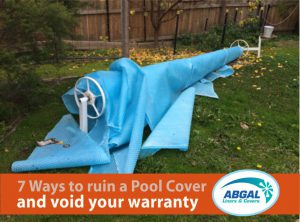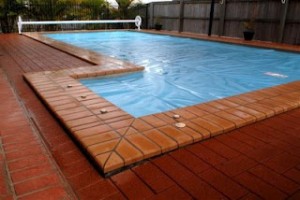- Not turning down automated chlorinators after a solar cover is installed. A cover reduces chlorine consumption by around 50% – if the chlorinator is not turned down, it will produce too much chlorine, and damage the cover. If your chlorinator is already running on its lowest setting, you can reduce the running time slightly, or add fresh water as needed.
- Not removing the cover after super chlorination. If you super chlorinate, always remove the cover first, and do not replace it until after chemical levels have returned to normal.
- Not keeping chemical levels to within the Australian Standard. Even being slightly over for a prolonged period of time will cause bleaching and brittleness of the cover. We recommend you test your pool chemicals regularly. You don’t need a full breakdown from your pool shop every weekend – just a quick check at home with some test strips is sufficient.
- Leaving a floating chlorine dispenser under the cover. While a floating chlorine dispenser is ok, they don’t float so well when they’re jammed under a cover. They will simply sit there, and cause a large concentration of chlorine in one area – and will damage your cover (causing bleach spots/burn), and probably damage the pool finish too.
- Leaving the cover exposed to sunlight when not on the pool. Solar covers are designed to attract and store heat. When a solar cover is rolled or folded, each layer gets hotter, and the temperatures build up through each layer. We have seen covers which have gotten so hot the layers closest to the reel have literally melted and fused together. To prevent this from happening, all ABGAL cover rollers are supplied with a protective overcover, which must be used when the cover is not on the pool.
- Improper storage. This picture? It wasn’t staged. It was literally what we saw whe
 n we went to visit a pool owner – and they knew we were coming!! They didn’t want it on the pool at the time, so they’d ‘moved it out of the way’ for a few days. When on a reel, or folded, a blanket should be covered with a heat reflective cover. If storing for an extended period of time, it should be rinsed with clean water, and allowed to dry thoroughly before storage – and stored in a covered and protected area, at below 45 degrees celcius.
n we went to visit a pool owner – and they knew we were coming!! They didn’t want it on the pool at the time, so they’d ‘moved it out of the way’ for a few days. When on a reel, or folded, a blanket should be covered with a heat reflective cover. If storing for an extended period of time, it should be rinsed with clean water, and allowed to dry thoroughly before storage – and stored in a covered and protected area, at below 45 degrees celcius. - Incorrect positioning on the pool. A solar cover shouldn’t be dragged over the pool deck, decorative rocks or sharp coping. And it should be cut to shape, so that it moves easily on the water. We’ve heard of people leaving them in a rectangular shape on a kidney shaped pool, then holding the edges down with bricks and rocks to stop them blowing off in the wind!
How to stop heat loss from my pool
The biggest cause of heat loss from a swimming pool is evaporation. A number of factors contribute to evaporation in your pool – air temperature compared to the water temperature, humidity level and the amount of wind blowing across the surface of the pool. The bigger the difference between the air temperature and the water temperature in a pool, the greater the evaporation and therefore the greater the heat loss. The same for low humidity environments, the potential for evaporation is increased when the humidity is low. When the wind is blowing across the surface of the pool, you increase the amount of evaporation and therefore heat loss.
If you are spending money to heat your pool, the last thing you want to do is throw that money down the drain… So invest in a good quality pool cover, and you’ll see the difference straight away! The pool cover will create a barrier between the wind and the water surface, and can also stop up to 99% of evaporation! A cover with good thermal properties will also stop heat loss through the fabric.
There are some different types of covers ranging from chemicals that coat the water surface, to floating rings to proper fabric covers. The chemicals and rings are not as effective as good quality fabric cover that is fully waterproof and covers the whole surface of the pool in one piece. The chemical style evaporates away by itself and needs to be continually added to be of any benefit. Rings – while they look cute, and (individually) stop evaporation, they are really not a practical solution as they leave lots of gaps which allow leaves and debris to fall through to the pool water. These eventually sink to the floor of the pool and need to be cleaned up by a pool vacuum or automatic pool cleaner. If you use a one piece fabric cover, it will help keep the leaves out of the pool as well as stop heat loss. Most fabric covers can be used in conjunction with a pool reel system to make covering and uncovering easier.
So if your main goal is to stop your pool from losing heat overnight, the best thing you can do is invest in a good quality, thermal pool cover.
Is your pool ready to swim?
Spring is here and, as the warmer weather coaxes us into the outdoors more, it’s time to get your pool ready to swim.
Is your pool too cold? Green and neglected? Full of leaves and debris? Or, all of the above? The solution is easy…
A cold pool is easily transformed into an oasis with a solar pool blanket. They raise your pool water temperature by up to 8 degrees C and can extend your swimming season by up to 3 months a year, so you can start swimming sooner.
A green pool usually means algae has started to grow in the water, due to lack of maintenance. Super chlorination is the quick fix, backed up with regular testing and adjusting to get the chemical balance just right for swimming again. Remember to remove your pool cover when super chlorinating!
If a pool full of leaves is getting you down, simply cover up with a fitted pool cover. There are many different styles available for both inground and above ground pools, salt water and chlorinated, specifically for keeping your pool leaf-free. They are cost effective and can pay for themselves in the first year, due to how much money you’ll save on chemicals and water. Plus, you’ll have more free time to swim in your crystal clear pool.
Fact #5b: Week 2 of “How often we fail, in our cover-up plan”
 When planning a new pool or refurbishing an existing pool and surround, the question to start with is not “Do I need a pool cover?” but rather, “What type of pool cover do I need?”
When planning a new pool or refurbishing an existing pool and surround, the question to start with is not “Do I need a pool cover?” but rather, “What type of pool cover do I need?”
Pool covers are an environmentally responsible part of owning a pool these days, but they are generally purchased after the pool and landscaping has been completed.
Keep your options open, by being smart and planning your pool cover in the beginning, when planning the rest of your pool entertainment area.
Start by asking yourself these questions…
• Will the pool be heated?
• Are there overhanging trees which will drop leaves into the pool?
• Is the pool exposed to high winds?
• Is it more important to reduce leaves, retain heat or reduce evaporation and therefore water loss?